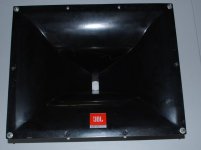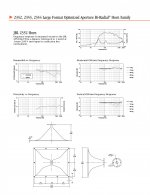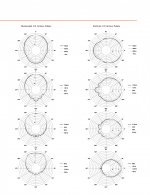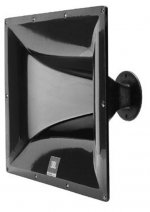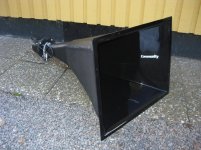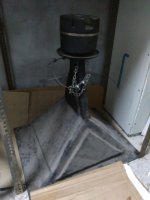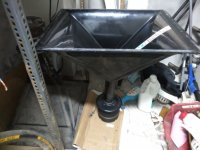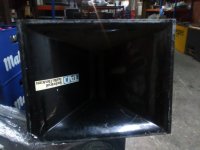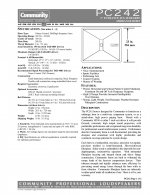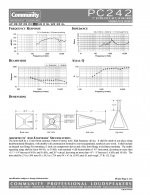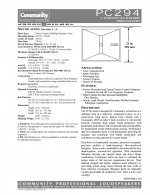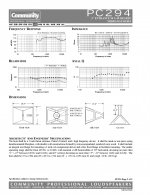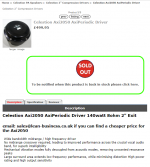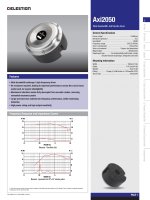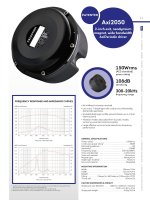The phase plug of the M4 driver is very resembling to the Axidriver.
They share some similarities, but the Axi2050's plug is more advanced. Which should come as no surprise, considering the claimed performance.
An externally hosted image should be here but it was not working when we last tested it.
Last edited:
Comment on the Axi2050 from a Norwegian forum, attributed to Bjørn Kolbrek:
"I got a change to one such driver on a straight circular Hypex horn at the Celestion factory, and it actually had a nice, smooth high end. Moreover, the driver is rated for 150W down to 300Hz, and the diaphragm is large, so for domestic use, using it down to 100Hz or even lower would not be a problem."
2 x Axi2050 + 2 x appropriate horn + 2 x 100 dB bass solution (tapped horn?), and you're good to go 🙂
If this is true, there's no need to construct a MEH.
"I got a change to one such driver on a straight circular Hypex horn at the Celestion factory, and it actually had a nice, smooth high end. Moreover, the driver is rated for 150W down to 300Hz, and the diaphragm is large, so for domestic use, using it down to 100Hz or even lower would not be a problem."
2 x Axi2050 + 2 x appropriate horn + 2 x 100 dB bass solution (tapped horn?), and you're good to go 🙂
If this is true, there's no need to construct a MEH.
Last edited:
mitchba, you may want to consider on of these:

Optimized aperture bi-radial horns (2354, 5353, 5352) are the last generation specified for a 500Hz crossover, before JBL switched to the PT-style waveguides.
There is a diffraction slot, but the throat of the 60° version doesn't look too bad.

Optimized aperture bi-radial horns (2354, 5353, 5352) are the last generation specified for a 500Hz crossover, before JBL switched to the PT-style waveguides.
There is a diffraction slot, but the throat of the 60° version doesn't look too bad.
This is the 5352 (90x50).
These are often for sale in scratched condition. You could wrap a piece of sandpaper around a metal strip and gently smooth out the sharp edges of the slot. Repaint them, et voilà!
These are often for sale in scratched condition. You could wrap a piece of sandpaper around a metal strip and gently smooth out the sharp edges of the slot. Repaint them, et voilà!
Attachments
Last edited:
Seems the late Zilch liked the 2352 a lot:
"2452H-SL has the extension 2447H/J lacks, plus Aquaplas-damped smoothness. I've run them on 2381 and 2352, and both of those combinations are top tier, in my experience."
The polars are not bad either.
"2452H-SL has the extension 2447H/J lacks, plus Aquaplas-damped smoothness. I've run them on 2381 and 2352, and both of those combinations are top tier, in my experience."
The polars are not bad either.
Attachments
Last edited:
It is.

Special order by the Russian government...
Wow that’s even more impressive than I thought! 😱
The MST Horns on top - quite big if you're underneath those - are completely dwarfed by the Mega Bass Horn.

Funktion One made millions on the large amounts of gear they supplied for the Sochi Olympics.
Danley Synergies would have been better suited to cover these large areas and stadiums. A hell of a lot cheaper, too.
But I don't think buying American was an option in the first place.

Funktion One made millions on the large amounts of gear they supplied for the Sochi Olympics.
Danley Synergies would have been better suited to cover these large areas and stadiums. A hell of a lot cheaper, too.
But I don't think buying American was an option in the first place.
Last edited:
Last post on Funktion One and slightly back on topic.
Until recently, I presumed Funktion One uses OEM Precision Devices and Fane drivers only.
This seems no longer to be the case.


(This Resolution speaker had not been opened before. The PD mid had to be replaced, not the B&C).
Until recently, I presumed Funktion One uses OEM Precision Devices and Fane drivers only.
This seems no longer to be the case.


(This Resolution speaker had not been opened before. The PD mid had to be replaced, not the B&C).
Last edited:
Gedlee was a little skeptical with that design, i hope it will perform well, he will perhaps be agreeably surprised (or not).They share some similarities, but the Axi2050's plug is more advanced. Which should come as no surprise, considering the claimed performance.
A 100Hz tractrix is absolutely gigantic and 99,999999% of humanity will reject immediately that acoustic solution.down to 100Hz or even lower would not be a problem."
A folded horn should be only avaliable alternative but it don't works, what can we do with that amazing performance ?
I can see why Dr. Geddes is sceptical about the design of the Axi2050's phase plug.
He probably wouldn't consider it useful to design a wideband driver like the Axi2050 in the first place.
If you simulate an infinite OS waveguide in hornresp, you'll find the cut-off is just below 1000Hz. Geddes largely ignores the notion of horn cut off.
You cannot design a wideband driver by "circumventing" the laws of physics. The BMS coaxials could be considered as an example of subdividing the initial physical challenge in 2 domains, by which (many) new issues are introduced.
That said, I think Geddes' phase plug patent is a very clever solution and it makes me wonder why it hasn't been implemented by manufacturers.
He probably wouldn't consider it useful to design a wideband driver like the Axi2050 in the first place.
If you simulate an infinite OS waveguide in hornresp, you'll find the cut-off is just below 1000Hz. Geddes largely ignores the notion of horn cut off.
You cannot design a wideband driver by "circumventing" the laws of physics. The BMS coaxials could be considered as an example of subdividing the initial physical challenge in 2 domains, by which (many) new issues are introduced.
That said, I think Geddes' phase plug patent is a very clever solution and it makes me wonder why it hasn't been implemented by manufacturers.
He is not totally wrong, i can't find any wideband horn able to cover the 100-20K range and the existing compression drivers are able to reach the highest octaves.I can see why Dr. Geddes is sceptical about the design of the Axi2050's phase plug.
He probably wouldn't consider it useful to design a wideband driver like the Axi2050 in the first place.
That said, I think Geddes' phase plug patent is a very clever solution and it makes me wonder why it hasn't been implemented by manufacturers.
It hasn't been implemented by manufacturers ?
A very well defended patent ?
The lack of R&D credits ?
The industrial or economical logic ?
The humanity is reaching the end, therefore we don't need it ?
Gedlee is so intelligent that everybody is jealous ?
Last edited:
Large bass medium horns
Hi Ro808, all
You introduced the Community PC194 horn to me, thank you. I am seeking more info on the design, basically to see if could be cloned and adapted to Renkus Heinz SSD5600 I own (2.4''), may you have a look pls ?Community PC194 horn drawing ?
Looking also for same info on Klipsch K402 you mentionned I spotted earlier.
Will compare to original RH CBH250-6 (60°) and CBH250-9 (90°), btw wondering if better for hifi use to take 90° horns for listening at 3-4 m.
Sorry for OT, it is very strange these large pre web horns have very little resources available
BR
Jean-Louis
Hi Ro808, all
You introduced the Community PC194 horn to me, thank you. I am seeking more info on the design, basically to see if could be cloned and adapted to Renkus Heinz SSD5600 I own (2.4''), may you have a look pls ?Community PC194 horn drawing ?
Looking also for same info on Klipsch K402 you mentionned I spotted earlier.
Will compare to original RH CBH250-6 (60°) and CBH250-9 (90°), btw wondering if better for hifi use to take 90° horns for listening at 3-4 m.
Sorry for OT, it is very strange these large pre web horns have very little resources available
BR
Jean-Louis
JLOP, you're welcome.
The PC194 is not a unique horn design per se. Apart from some details these are similar to other large format diffraction horns, as far as the overall horn contour is concerned.
I probably wouldn't use the longer Community horns at home, but I find the shorter "soft diffraction" horns very interesting.
Images 1-3: PC294, 2" exit brother of the PC194 is shown
Images 4-6: PC242.
The PC194 is not a unique horn design per se. Apart from some details these are similar to other large format diffraction horns, as far as the overall horn contour is concerned.
I probably wouldn't use the longer Community horns at home, but I find the shorter "soft diffraction" horns very interesting.
Images 1-3: PC294, 2" exit brother of the PC194 is shown
Images 4-6: PC242.
Attachments
Last edited:
He is not totally wrong, i can't find any wideband horn able to cover the 100-20K range and the existing compression drivers are able to reach the highest octaves.
That's what makes the Axi2050 (project) unique and rather fascinating, doesn't it?
It seems the engineers improved the Axi2050's performance, since it was first introduced.
It's quite difficult to compare the curves of the Exponential and the SEOS30 without knowing the specs of the former, but if you also take the PWT into account, the top octave response/output is definitely better in the latest datasheet.
2016/17 vs 2018:
It's quite difficult to compare the curves of the Exponential and the SEOS30 without knowing the specs of the former, but if you also take the PWT into account, the top octave response/output is definitely better in the latest datasheet.
2016/17 vs 2018:
Attachments
Last edited:
Noticed that as well. Still wondering what's taking so long. In development for five years before being presented at AES in 2015. Almost a decade now.
I'm not aware of any other driver that's been announced that long before being put into commercial products.
Measurements do look pretty impressive against BMS in the presentation uploaded on youtube...they mention manufacturing difficulty now that I'm looking back on it.
Here's a link with a series of articles about retrofitting EAW KF750's with new drivers including the Axi2050 for the midrange.
restomod Archives - ProSoundWeb
I'm not aware of any other driver that's been announced that long before being put into commercial products.
Measurements do look pretty impressive against BMS in the presentation uploaded on youtube...they mention manufacturing difficulty now that I'm looking back on it.
Here's a link with a series of articles about retrofitting EAW KF750's with new drivers including the Axi2050 for the midrange.
restomod Archives - ProSoundWeb
I posted the restomod articles earlier in this thread.
The aggregate development time might encompass research for related products, such as the Kef Tangerine Waveguide.
Time to market is extraordinary indeed and highly unusual for loudspeaker drivers.
Considering the complexity of the driver, more specifically the diaphragm, it makes sense to include a prolonged pre-launch test period among OEM clients.
If the Axi2050 lives up to the specifications/expectations, it's a revolutionary driver already.
The aggregate development time might encompass research for related products, such as the Kef Tangerine Waveguide.
I'm not aware of any other driver that's been announced that long before being put into commercial products.
Measurements do look pretty impressive against BMS in the presentation uploaded on youtube...they mention manufacturing difficulty now that I'm looking back on it.
Time to market is extraordinary indeed and highly unusual for loudspeaker drivers.
Considering the complexity of the driver, more specifically the diaphragm, it makes sense to include a prolonged pre-launch test period among OEM clients.
If the Axi2050 lives up to the specifications/expectations, it's a revolutionary driver already.
Last edited:
That's what makes the Axi2050 (project) unique and rather fascinating, doesn't it?
Grandaddy should try it on his western electric horn !
In Search Of Perfect Sound | Science Museum Blog
Last edited:
- Home
- Loudspeakers
- Multi-Way
- New Celestion "AxiPeriodic Driver"
